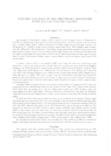An epizootic of Aujeszky's disease (AD) occurred in the Ponggol district in Singapore in 1977/78. An oil-adjuvant, inactivated vaccine was introduced to control the disease. Pigs vaccinated at 2 - 4 weeks of age, with or without a booster at 8 weeks of age, became clinically infected with AD between 3 - 5 months of age in several large commercial farms. The morbidity and mortality were 20 - 40% and 2 -8% respectively. The lesions of pigs which died appeared to be more severe than hitherto reported or seen for infected pigs of this age without prior vaccination. This led one of the authors to postulate that vaccination with this vaccine had hypersensitized some pigs to the AD virus. In view of the present findings some recommendations on the vaccination and control of AD are discussed.
Aujeszky's disease (AD) or pseudorabies (PR) is an acute and often fatal condition of pigs caused by a virus of the herpes group. Clinical infections of pigs have been reported in England (Mackay et al. 1962), Northern Ireland (Gordon and Luke, 1955), Europe (Pritulin et al. 1970; Toma et al. 1969; Canic, 1969; Borgen et al. 1969; Bitsch, 1971; Steek et al. 1974; Radnai, 1977; Pensaert et al. 1977), New Zealand (Burgess et al. 1976) and the United States (Shope 1935; Saunders et al. 1963; Olander et al. 1966). The earlier reports from the United States indicated that clinical AD primarily affected suckling pigs while the disease in older pigs was usually without clinical signs. More recent reports have described outbreaks in which clinical involvement of older swine has been a prominent feature.
Aujeszky's disease in pigs was first confirmed by virus isolation in Singapore in 1971, the virus being isolated from suckling pigs showing the typical nervous signs of the disease (Lim and Loi, 1975). Since then, an average of 4 cases were diagnosed annually up to 1976. In these cases, the virus appeared to affect only piglets. Although mortality in affected litter was high, the morbidity within affected farms was insignificant to justify control measures other than the culling of affected piglets.
In 1977 and 1978, there was a sudden increase in the incidence of the disease. Twenty-eight (28) outbreaks were reported in 1977, and 139 outbreaks in the first half of 1978 of which more than 140 occurred in the Ponggol district. The clinical manifestation of the disease also changed. Prior to 1977, the ADV affected only piglets. In the 1977/78 epizootic, pigs of all ages were affected. The disease was, however, still most severe in piglets where morbidity and mortality almost reached 100% in some farms. The next major loss was caused by abortions which in some farms affected 90% of pregnant sows. Morbidity in matured boars was also high; many boars developed swelling of the scrotum with subsequent sterility as a sequela. The effects of the ADV in weaners and fatteners were variable with morbidity ranging from 5 -100% and mortality 0 -25%. (Ngiam et al., 1978).
An oil-adjuvant inactivated vaccine was introduced in May 1978 in an effort to control the disease. This paper describes the experiences encountered in the field with the use of this vaccine.

